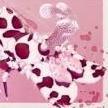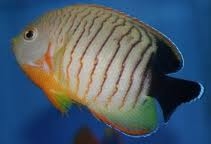Search the Community
Showing results for tags 'Centropyge eibli'.
-

Eibl's Angelfish ( Centropyge eibli )
Harlequinmania posted a gallery image in Dwarf Angelfish (Centropyge)
Scientific Name : Centropyge eibli Reef Compatible : With Caution Care Level : Beginner Disposition : Semi-aggressive Min. Tank Size : 30 gallons Mature Size : 6 inches Diet : Omnivore Range : Indo-Pacific, Sri Lanka, Fiji, Australia, Indian Ocean Other Common Names Orangelined Angelfish, Red Stripe Angelfish, Blacktail Angelfish Description One of the larger of the dwarf Angelfishes, the Eibli (ee-blee-eye) Angelfish is not terribly aggressive. It is one of the hardiest of all dwarf Angelfish and one of the best for beginners. They are considered fairly reef safe as juveniles but may develop a taste, especially for brain type LPS corals as they mature. Keep their diet varied and keep them well fed to avoid this problem. They will not bother non-sessile invertebrates such as shrimp or crabs. Although they are one of the least aggressive of the dwarf Angelfish, they still will show aggression toward their own species. They are a great candidate for a multiple species dwarf Angelfish tank and should be added first before other Centropyge species are added. In the wild, they are known to breed with the Half-Black Angelfish (C. vrolikii) producing some very interesting offspring. Although this does not happen in captivity, the Half-Black Angelfish makes a wonderful tank mate for the Eibl's Angelfish as long as they are added at the same time. Diet In the wild the Eibli Angelfish has a varied diet consisting of algae and crustaceans. The Eibli Angelfish is not considered reef safe as it may nip at large polyped stony corals, soft corals, zoanthids and clam mantles. There are occasional specimens that live very long lives in reef aquaria as peaceful citizens but the majority of these fish will often turn for no apparent reason when they are older. This may be easily explained as many of the Centropyge family are predominately plankton eaters as juveniles and will switch to consuming it’s natural adult diet once fully grown. Sometimes all it takes is for an underfed individual to ‘test’ a food source. This being the case, be sure to add this specimen to a well established tank and feed frozen mysis shrimp, meaty crustaceans such as shrimp and clam. Be sure to include algae such as spirulina.

